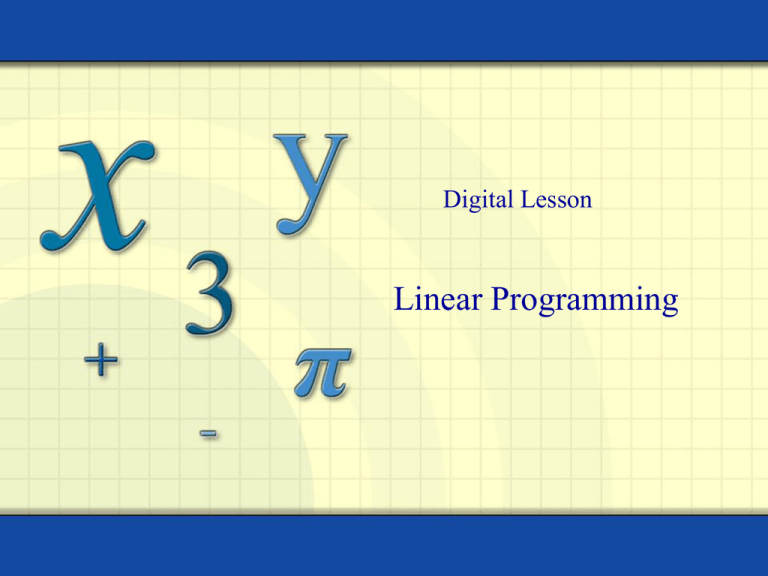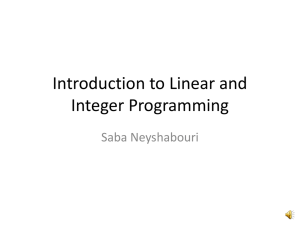
Digital Lesson
Linear Programming
Linear programming is a strategy for finding the optimum
value – either maximum or minimum - of a linear function that is
subject to certain constraints.
These constraints, or restrictions, are stated as a system of
linear inequalities.
Example: Find the maximum value of z, given:
2 x 5 y 25
3 x 2 y 21
z = 3x + 2y and
x0
y0
objective function
constraints
Example continued
Copyright © by Houghton Mifflin Company, Inc. All rights reserved.
2
The system of linear inequalities determines a set of
feasible solutions. The graph of this set is the feasible region.
Example continued: Graph the feasible region determined by the
2 x 5 y 25
system
of constraints.
3 x 2 y 21
x0
3x 2 y 21
y
y0
feasible region
x=0
2 x 5 y 25
x
y=0
Example continued
Copyright © by Houghton Mifflin Company, Inc. All rights reserved.
3
If a linear programming problem has a solution, then the solution
is at a vertex of the feasible region.
Example continued: Maximize the value of z = 2x +3y over the
feasible region.
y
(0, 5) z = 2(0) + 3(5) = 15
(5, 3) z = 2(5) + 3(3) = 19
Maximum value
of z
feasible region
(0, 0)
z = 2(0) + 3(0) = 0
(7, 0) z = 2(7) + 3(0) = 14
x
Test the value of z at each of the vertices. The maximum value of
z is 19. This occurs at the point (5, 3) or when x =5 and y = 3.
Copyright © by Houghton Mifflin Company, Inc. All rights reserved.
4
Solving Linear Programming Problems Graphically
1. Graph the feasible region.
2. Find the vertices of the region.
3. Evaluate the objective function at each vertex.
4. Select the vertices that optimize the objective function.
a) If the feasible region is bounded the objective function
will have both a maximum and a minimum.
b) If the feasible region is unbounded and the objective
function has an optimal value, the optimal value will
occur at a vertex of the feasible region.
Note: If the optimum value occurs at two vertices, its value is the
same at both vertices and along the line segment joining them.
Copyright © by Houghton Mifflin Company, Inc. All rights reserved.
5
Example: Find the maximum and minimum value of z = x + 3y
subject to the constraints –x + 3y 6, x –3y 6, and x + y 6.
1. Graph the feasible region.
Maximum value
of z
y
z = 3 + 3(3) = 12
x 3y 6
(3, 3)
(0, 2)
z = 0 + 3(2) = 6
(6, 0) z = 6 + 3(0) = 6
x
x 3y 6
x y 6
2. Find the vertices.
3. Evaluate the objective function at each vertex.
4. The maximum value of z is 12 and occurs at (3, 3).
The minimum value of z is 6 and occurs at both (0, 2) and (6, 0)
and at every point along the line joining them.
Copyright © by Houghton Mifflin Company, Inc. All rights reserved.
6
Rewriting the objective function z = x + 3y in slope-intercept
1
z
form gives y x . This equation represents a family of
3
3
parallel lines, one for each value of z.
y
1
z 6 y - x2
3
1
z 3 y - x 1
3 (0, 2)
1
z0 y- x
3
(3, 3)
(6, 0)
1
z 15 y - x 5
3
1
z 12 y - x 4
3
1
z 9 y - x3
x
3
As z increases through values 0, 3, 6, 9, 12, and 15, the
corresponding line passes through the feasible region.
The point at which the family of lines first meets the feasible
region gives the minimum value of z, and the point at which the
family of lines leaves the feasible region gives the maximum.
Copyright © by Houghton Mifflin Company, Inc. All rights reserved.
7
Example: Minimize z = 3x – y subject to
x – y 1, x + y 5, x 0, and y 0.
vertex
value of z at vertex
(0, 0)
(1, 0)
(3, 2)
(0, 5)
z = 3(0) – (0) = 0
z = 3(1) – (0) = 3
z = 3(3) – (2) = 7
z = 3(0) – (5) = –5
x y 1
y
(0, 5)
(3, 2)
(0, 0)
x = 0 (1, 0)
y=0
x
x y 5
The minimum value of z is –5 and this occurs at (0, 5).
Copyright © by Houghton Mifflin Company, Inc. All rights reserved.
8
Example: Maximize z = 2x + y subject to 3x + y 6, x + y 4,
x 0, and y 0.
y
(0, 6)
Since the feasible region is unbounded
there may be no maximum value of z.
(1, 3)
For x 4, (x, 0) is a feasible solution.
(4, 0)
At (x, 0), z = 2x.
x
3x y 6 x y 4
Therefore as x increases without bound, z increases without
bound and there is no maximum value of z.
Copyright © by Houghton Mifflin Company, Inc. All rights reserved.
9
Example: Sarah makes bracelets and necklaces to sell
at a craft store. Each bracelet makes a profit of $7, takes 1 hour
to assemble, and costs $2 for materials. Each necklace makes a
profit of $12, takes 2 hour to assemble, and costs $3 for materials.
Sarah has 48 hours available to assemble bracelets and necklaces.
If she has $78 available to pay for materials, how many bracelets
and necklaces should she make to maximize her profit?
To formulate this as a linear programming problem:
1. Identify the variables.
2. Write the objective function.
3. Write the constraints.
Example continued
Copyright © by Houghton Mifflin Company, Inc. All rights reserved.
10
Example continued:
1. Let x = the number of bracelets Sarah makes
Let y = the number of necklaces Sarah makes
2. Express the profit as a function of x and y.
p = 7x + 12y
Function to be maximized
3. Express the constraints as inequalities.
Cost of materials:
Time limitation:
2x + 3y 78.
x + 2y 48.
Since Sarah cannot make a negative number of bracelets or
necklaces, x 0 and y 0 must also hold.
Example continued
Copyright © by Houghton Mifflin Company, Inc. All rights reserved.
11
Example continued:
Maximize p = 7x + 12y subject to the constraints
2x + 3y 78, x + 2y 48, x 0, and y 0.
2 x 3 y 78
y
(0, 24)
z = 288
(12, 18) z = 300
(0, 0)
z=0
(39, 0)
z = 273
x
x 2 y 48
Sarah should make 12 bracelets and 18 necklaces for a
maximum profit of $300.
Copyright © by Houghton Mifflin Company, Inc. All rights reserved.
12









